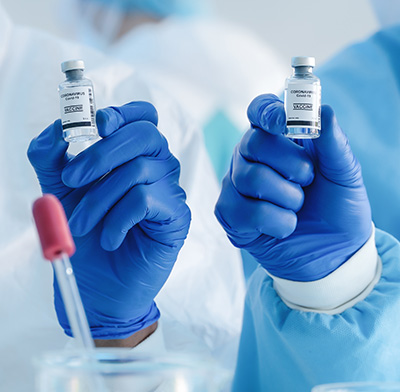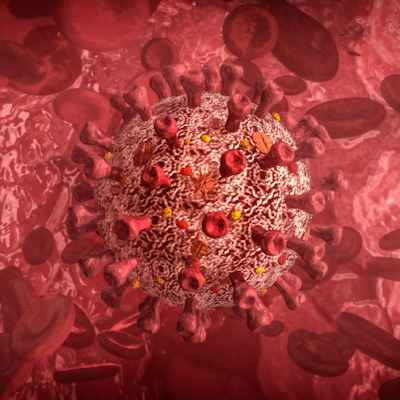February 1, 2021 -- An analysis of antibody and T-cell responses during the entire timeline of SARS-CoV-2 infection reveals the different ways the immune system responds to the virus in the early phases of COVID-19 disease. The results, published in Cell Reports on January 21, suggest that T-cell responses may be important for controlling infection while antibodies provide longer protection.
SARS-CoV-2 infection elicits both virus-specific humoral (antibody responses produced by B cells) and cellular (antigen-triggered T-cell responses) immunity. However, their independent roles on viral control and disease pathogenesis require further clarification.
Reduced disease severity has been associated with virus-specific T-cell responses and/or SARS-CoV-2 antibodies. However, most of this data come from studies analyzing patients during the convalescent period and not during active infection.
The researchers at Duke-National University of Singapore (NUS) Medical School followed 12 patients with SARS-CoV-2 infection from symptom onset to convalescence or death. They quantified SARS-CoV-2 viral load in the upper respiratory tract and SARS-CoV-2-specific antibodies and T cells at multiple time points.
"We found that patients who control SARS-Cov-2 infection with only mild symptoms are characterized by an early induction of IFN-γ secreting SARS-CoV-2 specific T cells. The amount of humoral response, however, does not predict the level of COVID-19 disease severity," said co-author Anthony Tanoto Tan, PhD, senior research fellow at the Duke-NUS Emerging Infectious Diseases (EID) program, in a statement.
T-cell responses do not correlate to more severe COVID-19 disease
Using an interferon (IFN)-γ enzyme-linked immunospot (ELISPOT) assay, the researchers assessed T-cell responses in epitopes across the spike protein, including the whole nucleoprotein (NP), membrane (M), the open reading frames (ORF)7ab, ORF8, ORF3a, the nonstructural protein (NSP)7, and the NSP13 of ORF1ab.
They observed that the overall magnitude of SARS-CoV-2 specific T cells was not proportional to the severity of disease. There were higher frequencies of IFN-γ-secreting cells in both early stages (day one-15) and late stages (day 15-30) were present in mild COVID-19 patients but not in moderate/severe patients.
They also found a statistically significant direct correlation between early appearance of SARS-CoV-2 peptide-reactive cells (specific for NP, ORF7/8, ORF3a, M, and the spike protein) and a shorter duration of infection.
"Our data supports the idea that SARS-CoV-2 specific T cells play an important role in the rapid control of viral infection and eventual clearance of the disease," added co-author Martin Linster, PhD, senior research fellow with the Duke-NUS EID program.
"It is time that T cell monitoring should be considered in providing a comprehensive understanding of the immune response against SARS-CoV-2. This would also mean that a vaccine will likely be more effective if a holistic induction of both antibodies and T cells occurs," said senior author, Antonio Bertoletti, PhD, professor at the Duke-NUS EID program.
Antibody responses do correlate to more severe COVID-19 disease
In the study, the most severe cases of COVID-19 showed the most rapid and robust ability to neutralize the virus and therefore the highest overall quantities of SARS-CoV-2-specific antibodies. The researchers characterized virus neutralization using a surrogate virus neutralization test that quantified the ability of serum antibodies to inhibit binding of the spike receptor binding domain to the angiotensin-converting enzyme 2 (ACE2) receptor in vitro.
The peak neutralizing activity in patients was achieved within nine-15 days after symptom onset. Patients with moderate/severe symptoms exhibited stronger virus-specific antibody responses than those with mild disease. Most peptide-responsive T cells were CD4 cells, but CD8 T cells specific to NP peptide pools were also detected. Because the frequency of SARS-CoV-2-specific T cells rapidly waned after SARS-CoV-2 clearance, the authors noted that the time of T-cell analysis can significantly influence the magnitude of the T-cell response detected.
ORF7/8-specific T cells were preferentially detected during the acute phase of infection, which corresponded to an increase in ORF8-specific antibodies during the early phases of SARS-CoV-2 infection. This triggered a robust IFN-γ response preferentially in the early phases of infection but only in patients with mild disease. Furthermore, these patients with mild symptoms cleared the virus early in the disease progression.
"This important study furthers our understanding of the immune response against SARS-CoV-2. It has far-reaching implications including on COVID-19 vaccine design and the subsequent monitoring of vaccine response," said Patrick Casey, PhD, senior vice dean for research at Duke-NUS.
Do you have a unique perspective on your research related to infectious diseases or virology? Contact the editor today to learn more.
Copyright © 2021 scienceboard.net










